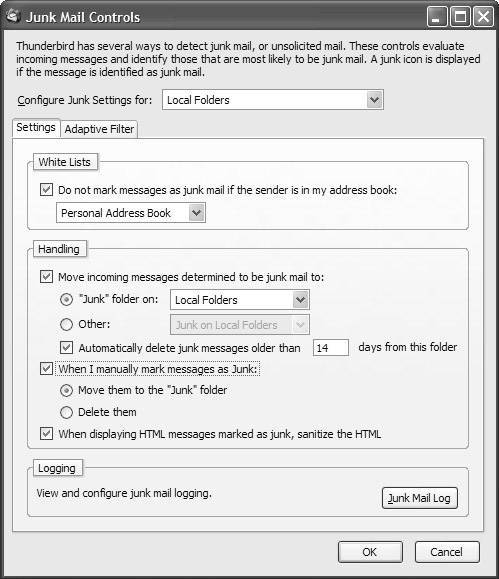Setting up the Thunderbird Junk Email Filter
| Thunderbird uses a Bayesian filter, based on a probability theorem developed by the Reverend Thomas Bayes in the 17th century. You can look up Bayes's work and the math behind it at www.wikipedia.org if you like, but in practical terms as it applies to spam filtering, you might paraphrase Bayes's theorem this way: "If an email has more than x number of characteristics found in previous spam emails, this email is also likely to be spam. But if it has y number of another set of characteristics, it is probably not spam." The beauty of using the Bayesian method to filter spam is that you create your own definition of spamor, as Thunderbird calls it, "junk email." Some people like receiving emails advertising new computer gear, for instance, while they detest getting emails selling weight-loss drugs. Others may be interested in weight loss but dislike pornography offers. Windows users probably want to declare all emails with unexplained attachmentswhich can easily carry worms, viruses, or other malwarejunk, while a virus researcher running Linux (which is not affected by Windows malware) may want to receive those emails. You train your Thunderbird junk filter to match your personal preferences. This takes no math skills. You download some email and click each one you consider junk. After a few hundred clicks, the program automatically decides which emails are junk and which aren't, based on your input. Consider the typical email download shown here. You see some email headers. Chances are that at least a few of those emails are junk. Highlight one so that the message body appears. If it's junk, click the dot to the right of the Sender listing, and a trash can appears. The Thunderbird inbox. 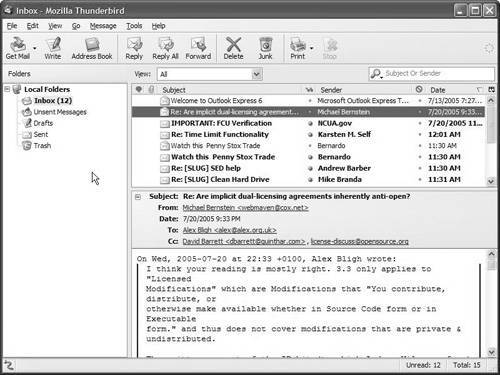 Declaring an email a piece of junk. 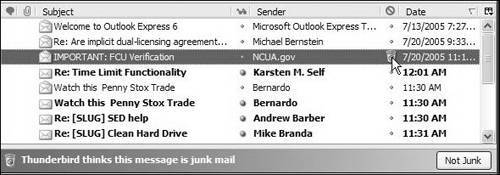 This email, which is a phishing scam that pretends to come from a credit union, is now junk in the eyes of Thunderbird's Bayesian filter. You go through your current emails andno surpriseend up marking more than half of them as junk. Seven out of 12 emails are junk. 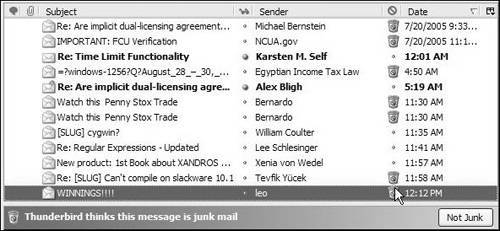 Remember, someone interested in Egyptian income tax law might decide not to mark that email as junk. This is why it's good to "train" your own email filter instead of letting someone else decide which email you should and shouldn't receive in your inbox. But in any case, you can decide with Thunderbird. You can also change your mind after you declare an email junk by clicking the trash can or the Not Junk button below and to the right of the list of emails in your inbox to unjunk it. Once you've decided what is and isn't junk, it's time to decide what you want to do with your junk email. At the very top of the Firefox window, select Tools and then Junk Mail Controls. The Thunderbird Tools menu.  This brings up the Junk Mail Controls dialog box. The boxes checked in the figure provide a good set of defaults. As with all Thunderbird settings, you can change them later, so there is no need to agonize over your settings before making your choices. Thunderbird junk mail settings. Now, whenever you mark an email as junk, it will go to the junk folder all by itself, as will the emails that the Bayesian filter decides are junk as it learns your preferences, which usually takes several hundred emails. The next step in this process is to monitor your junk folder for a week or so and make sure that no emails have landed there that shouldn't have. If you find some, mark them "Not Junk." After a while the filter will stop automatically marking emails as junk that you really want to see. The last stepand this one is necessary only if you get thousands of emails every weekis to periodically go into your Junk folder and clean it out by selecting Tools > Delete Mail Marked as Junk in Folder. If you used the settings suggested here, your Junk folder will automatically cleanse itself of all junk email that is more than 14 days old. (Yet another alternative is to set it to self-clear after 10 days or three days or any other interval you like.) Deleting mail marked as junk. 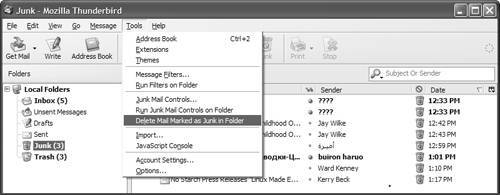 |
EAN: 2147483647
Pages: 143
